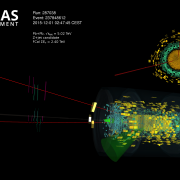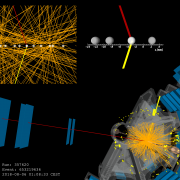Access to Collaboration Site and Physics Results
Jets are collimated sprays of hadrons generated from quarks and gluons, produced either directly in the proton-proton collision or as a part of the decay of W bosons, Z bosons, Higgs bosons, top quarks or new particles yet to be discovered. In fact, all W, Z and Higgs bosons decay most often to quarks which form jets.

New particles that may decay to quarks or gluons are likely to interact through the strong force – the force that holds colliding protons together and is responsible for most of the LHC proton collisions. Thus, if such new particles were to exist, they could be produced in copious amounts in the higher energy collisions now being recorded at ATLAS. These new particles could be detected by measuring of their decay products: highly energetic jets.
For all these reasons, it is of great importance that we understand how our detector reconstructs jets and their production in the Standard Model at the beginning of Run 2. Preliminary results describe how ATLAS is reconstructing jets in Run 2 and the accuracy with which their energy can be measured. With little data collected so far, the collaboration is relying on detailed studies performed on 2012 data together with simulations predicting the detector changes between Run 2 and Run 1. So far, the accuracy is slightly lesser at low energies, but comparable at high energies as illustrated by Figure 1.
Thus, if such new particles were to exist, they could be produced in copious amounts in the higher energy collisions now being recorded at ATLAS. These new particles could be detected by measuring of their decay products: highly energetic jets.
With this understanding of jet reconstruction, ATLAS has measured the cross section of jet production using early Run 2 data at 13 TeV. The preliminary result of the inclusive-jet cross section measurement is shown in Figure 2. The theoretical prediction is compared to the data and shows that it describes it well. Even though its kinematic phase space is still limited, the measurement is a first step for further searches of new particles and more stringent tests of the Standard Model.









